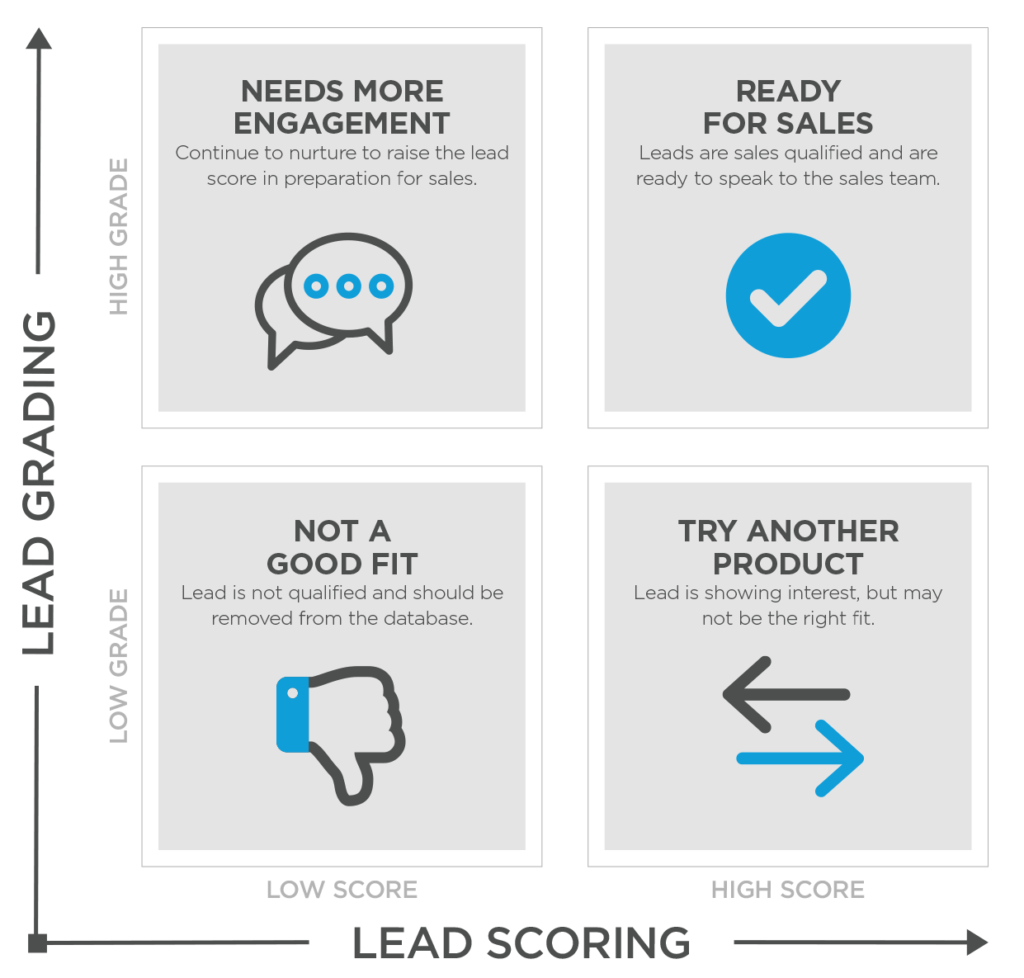What You Need to Know About Lead Scoring and Lead Grading
What is lead scoring? How is it different from lead grading? Why use either one and how could you possibly use them together? Lead scoring and grading strategies can be developed by the marketing and sales teams to help determine patterns of sales qualified leads and define the point that sales should start their communication. Tying these strategies together and implementing them within marketing or sales technology automates this entire process from a lead’s first touchpoint to their sales-qualified status.
As leads are introduced to your brand and start becoming more aware of your offerings, they are increasing their preparedness to speak to a member of your sales team. If a sales rep speaks to a lead too soon, they can risk wasting their time on someone who is not ready to make a decision. This is why most inbound leads go through stages of becoming Marketing Qualified Leads (MQL) and then Sales Qualified Leads (SQL) to mark the lead’s transition from brand awareness and education to decision-making.
Defining these lead transition requirements and automating the process makes the marketing-to-sales hand-off more efficient and reliable. At SmartAcre®, we build lead scoring and grading models to implement in marketing automation and CRM platforms, like Marketo and Salesforce, to enable this automation. Lead scoring and lead grading act as two separate lead quantifiers, but they work together to mark a lead as SQL at just the right time.
Lead Scoring vs. Lead Grading
The first thing to note is that there is a clear difference. More often than not, we see businesses confusing the two or using them incorrectly. Let’s start by setting things straight.
Lead Scoring
Lead scoring is based on a lead’s behavior. This is not a lead’s company, geography or industry (that’s lead grading – keep reading!), but is strictly based on a lead’s activity. Points are attributed based on a lead’s actions and are potentially taken away for inactivity. The higher the score, the more interested a lead is and therefore better suited for a sales conversation.
Why It’s Important
By attributing point values to specific actions, the lead score is regulated across all leads. For example, downloading a white paper could be worth 15 points as it demonstrates a high-level of interest, whereas opening an email may only be worth 2 points. In addition to adding points for positive behavior, the absence of behavior can remove points. Negative scoring associated with lead decay could be set up to subtract 10 points once a lead has been sent three emails and hasn’t opened any, or could remove 20 points if a lead has gone two months without visiting your website.
Lead Grading
Lead grading is not regulated across all leads, but instead, is regulated based on demographic information. By defining your buyer personas, ideal customer profiles, or target accounts, you can define the lead-level or company-level information that would indicate a lead’s fit for your product.
Why It’s Important
As an enterprise SaaS company, you may be looking for companies making over $25M in annual revenue with more than 10,000 employees, because they are the best fit for your product. If a lead comes in matching that description, they could receive the highest grade possible, an A. However, if a lead comes in from a company making $25M annually with only 7,000 employees, they would not be disqualified, but would have a lower grade, like a B.
In Simpler Terms:
Lead scoring is based on behaviors.
Lead grading is based on demographics.
Using The Relationship To Make Your Sales Team Happy
Once the lead scoring and grading criteria are defined, the two can be combined to determine the ideal next step for each lead. Here are some best practice lead-score-to-lead-grade relationships that can help you in pairing grades and scores together to determine the optimal time to send a lead to sales:
High score and low grade
Leads that are showing interest but are not the best fit may be better suited for another product or may not be the right contact within the company. These leads can also be evaluated for job-seeker behavior that should never be flagged to sales.
Low score and high grade
Leads who are a great fit but are showing minimal interest may not in a position to make a purchasing decision yet or may not be fully aware of the features and benefits of your product. They should continue to be nurtured to raise the lead score and educate the lead on products and services so they are ready to talk to sales.
High score and high grade
Leads who show high interest and who are a great fit for your product or service should be prioritized and sent to sales. Consider setting up a notification so the sales rep knows how to handle these leads.
Low score and low grade
These leads are not qualified for marketing or sales interaction and should be deleted from your database.
Start Your Strategy
Start implementing a lead scoring and grading strategy that will give sales teams more qualified leads, provide deeper insight into lead activity and behavior, and evolve your demand generation. If you’re not sure how to get started, our team can help.




